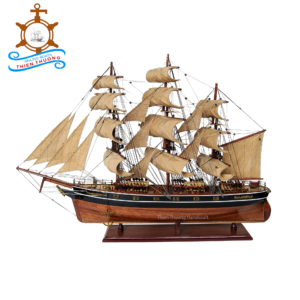Product Description
Sorry, this item is no longer available for sale. If you initiate a reproduction request, we need a min order of 10-20 units/item.
Sorry, this item is no longer available for sale. If you initiate a reproduction request, we need a min order of 10-20 units/item.
| Dimensions | 57L x 10W x 73H (cm) |
|---|

Viking ships were marine vessels of particular designs used and built by the Vikings during the Viking Age. The boat-types were quite varied, depending on what the ship was intended for, but they were generally characterized as being slender and flexible boats, with symmetrical ends with true keel. They were clinker built, which is the overlapping of planks riveted together. Some might have had a dragon's head or other circular object protruding from the bow and stern, for design, although this is only inferred from historical sources.

'Juan Sebastián de Elcano is a training ship of the Spanish Navy. It is a four-masted topsail, steel-hulled barquentine (schooner barque). At 113 meters (371 ft) long, it is the third-largest tall ship in the world and is the sailing vessel that has sailed the furthest, covering more than 2,000,000 nautical miles (3,700,000 km; 2,300,000 mi) in its lifetime.
It is named after Spanish explorer Juan Sebastián Elcano, captain of Ferdinand Magellan's last exploratory fleet and the man who completed the first circumnavigation of the world. The ship carries the Elcano coat of arms, which was granted to the family by Emperor Charles I following Elcano's return in 1522 from Magellan's global expedition. The coat of arms is a globe with the motto “Primus Circumdedisti Me” (meaning: “First to circumnavigate me”).'

Construction of the vessel began in 1795 at Hartt Shipyard in Boston following the design of Joshua Humphrey from Philadelphia. The CONSTITUTION was launched in October 1797 and was completed in 1798. She was armed with 44 cannons, including 30 long-barrelled 24-pounders.
In the war between England and France (1812-1814) the CONSTITUTION led a successful engagement against the frigates GUERRIERE (with 38 cannons) and JAVA. Her last wartime voyage was in February 1815.

In 1869 John Willis, a shipowner and ship's captain from London, commissioned the building of the clipper CUTTY SARK in order to beat the THERMOPYLAE (built one year before) in the “tea race”. The name CUTTY SARK is of Scottish origin and means “short shirt”. The figurehead is a witch called Nannie.
Under 1877 the full-rig ship sailed almost exclusively as a tea dipper on the China route and she frequently achieved speeds of up to 17 knots. Then from 1877 onwards the CUTTY SARK served mainly in the Australian wool trade

Reviews
There are no reviews yet.